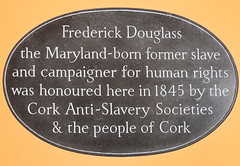Frederick Douglass


Frederick Douglass
(1818-1895)
Commemorated on 12 plaques
Frederick Douglass the Maryland-born former slave and campaigner for human rights was honoured here in 1845 by the Cork Anti Slavery Societies and the people of Cork
Imperial Hotel, South Mall , Cork, Ireland where they was (1844)
Frederick Douglass American abolitionist, social reformer and statesman spoke in City Hall 9th Oct. 1845
City Hall, The Mall, Waterford, Ireland where they spoke (1844)
Frederick Douglass (1818-1895). Champion of human freedom, African American abolitionist, newspaper editor, U.S. Colored Troops recruiter, U.S. ambassador to Haiti, and orator, Frederick Douglass gave his last public address "Against Lynch Law" here on February 1, 1895. A frequent visitor to West Chester, Douglass denounced lynching and bigotry and urged freedom, justice, and equality for all Americans. The Frederick Douglass Institute here maintains Douglass' legacy.
West Chester Univ. campus, between Library and Main Hall, facing High St, West Chester, PA, United States where they spoke (1895)
Hosanna Meeting House. Founded by free Blacks who had settled in this area, it was first known as the "African Meeting House." Formally organized in 1843 as an African Union Methodist Protestant church. A station stop on the Underground Railroad, its many visitors included Frederick Douglass and Sojourner Truth.
Old US 1 (Baltimore Pike) near Ashmun Rd., N of Lincoln University campus, Lower Oxford Township, PA, United States where they visited
Underground Railroad. In the 1850s this area, known as Tanner's Alley, was important on the Underground Railroad. Fugitive slaves hid at Joseph Bustill's & William Jones's houses, a block apart. Frederick Douglass & William Lloyd Garrison spoke at Wesley Union AME Zion Church nearby.
In Capitol Park, Walnut St. near Commonwealth Ave., Harrisburg, PA, United States where they spoke near
Frederick Douglass and John Brown. The two abolitionists met at a stone quarry here, Aug. 19-21, 1859, and discussed Brown's plans to raid the federal arsenal at Harpers Ferry. He urged Douglass to join an armed demonstration against slavery. Douglass refused, warning the raid would fail; the Oct. 16, 1859 attack confirmed his fears. Brown was captured with his surviving followers and was executed Dec. 2, 1859.
West Washington St., behind Southgate Mall, Chambersburg, PA, United States where they was (1859)
Frederick Douglass 1818-1895 American Social Reformer Author, Orator and Statesman stayed in a house on this site 1846
5 Whitehead's Grove, London, United Kingdom where they stayed
5 Summerhill Grove Frederick Douglass c. 1818-1895 I would unite with anybody to do right and with nobody to do wrong. African American abolitionist, author and social reformer. One of many fugitive slaves who stayed here with the Richardson family. Henry Richardson, his wife Anna and sister Ellen were Quakers and anti-slavery activists who helped raise funds for Douglass to formally buy his freedom in 1846.
5 Summerhill Grove, Newcastle upon Tyne, United Kingdom where they visited (1845)
Frederick Douglass 1818-1885. American author, orator, philosopher, freedom-fighter and statesman, lived here 1846. 'My part has been to tell the story of the slave.'
33 Gilmore Place, Edinburgh, United Kingdom where they lived (1845)
St. Lawrence Hall 1850 St. Lawrence Hall, one of the oldest public buildings in Toronto, was constructed following the Great Fire of 1849 that destroyed a large part of the city's core. Architect William Thomas designed the building in the Renaissance Revival style with Corinthian columns and a domed cupola. The entrance originally led to a shopping arcade connected to the St. Lawrence Market. The building had shops on the main floor and, on the upper floors, offices and a grand meeting hall used for social events and by prominent speakers, performers, and musicians. Abolitionist Frederick Douglass, Swedish soprano Jenny Lind, and showman P. T. Barnum all appeared in the hall, as did William Lyon Mackenzie, Toronto's first mayor and Upper Canada Rebellion leader. In the 20th century, St. Lawrence Hall lost prominence and fell into disrepair. By 1965, it was partially derelict and threatened with demolition. A campaign led by architect Eric Arthur resulted in the restoration of the building and its recognition as a National Historic Site in 1967.
157 King St East, Toronto, ON, Canada where they was
African American abolitionist Frederick Douglass Spoke here 30 Jan 1846
West Bell Street, Dundee, United Kingdom where they spoke (1846)
Frederick Douglass. Near here, on November 2nd 1846, the famous African-American abolitionist addressed the people of Hawick about the iniquities of slavery. Born on a Maryland plantation in 1817, before escaping he taught many of hos fellow slaves to read. Adopting the surname Douglass from a character in Sir Walter Scott's 'Lady of the Lake', he spoke frequently at abolitionist meeting. After the publication of his autobiography, Frederick became a literary sensation. This brought him to the attention of his previous 'owner', who tried to reclaim his 'property'. To avoid this, Douglass set sail for Europe, where his speeches continued, eventually helping bring about the legal abolition of slavery. sadly the evil practice still continues in many places - even here.
St Margaret's Drive, Hawick, United Kingdom where they spoke near







